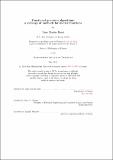| dc.description.abstract | The study of quantum algorithms is stymied by a lack of human intuition—many of these algorithms appear to rely on non-intuitive attributes unique to quantum mechanics, and as such 'good' quantum algorithms are often sporadic, non-intuitive, and requiring of bespoke analysis. The quantum algorithmist is up against a triple headwind: they must (1) be delusion-hardened against non-generalizing classical heuristics, (2) have understanding of disparate classical algorithms with which to compare their work, and (3) do this all largely without access the high-level programming abstractions ubiquitous in classical computer science for over seventy years.
A partial remedy for these problems has emerged with the development of a new class of quantum algorithms, quantum signal processing (QSP) and quantum singular value transformation (QSVT), which have had success in unifying, simplifying, and improving most known quantum algorithms. QSP/QSVT transform the spectrum of linear operators encoded in unitary processes by near arbitrary continuous functions, and this simple ability—computing matrix functions quantum mechanically—has been shown to subsume diverse tasks with comparatively simple complexity analysis.
This thesis claims and provides a series of constructions supporting that QSP and QSVT should not be viewed solely as subroutines for transforming linear systems, but as limited examples among an extensive class of quantum algorithms converting algorithmic problems to simpler algebraic ones. We construct an array of algorithms in this class, which we call functional quantum algorithms, and show they ought to and can be manipulated and combined purely at the level of this algebraic reduction to constitute useful, composite quantum algorithms.
We emphasize three constructions (among a collection of auxiliary results), ordered by complexity: (a) a limited extension of QSP/QSVT-like circuit ansätze to the multivariable matrix function setting, (b) a construction of recursively composable univariate QSP/QSVT-like subroutines, and (c) a construction of modular quantum subroutines (gadgets) that can approximate generic multivariable continuous matrix functions. We provide necessary and sufficient conditions under which these algorithms can be analyzed and combined functionally, i.e., purely at the level of the scalar transformations applied, and show these assertions require significant doing. Given our constructions' violation of basic assumptions of standard QSP and QSVT, we necessarily provide alternative proof techniques and quantum subroutines of independent interest. Finally, we also situate functional quantum algorithms among existing constructions in classical functional programming, identifying them as instances of monads, suggesting concrete directions for high-level, flexible quantum algorithmic design and analysis. | |
